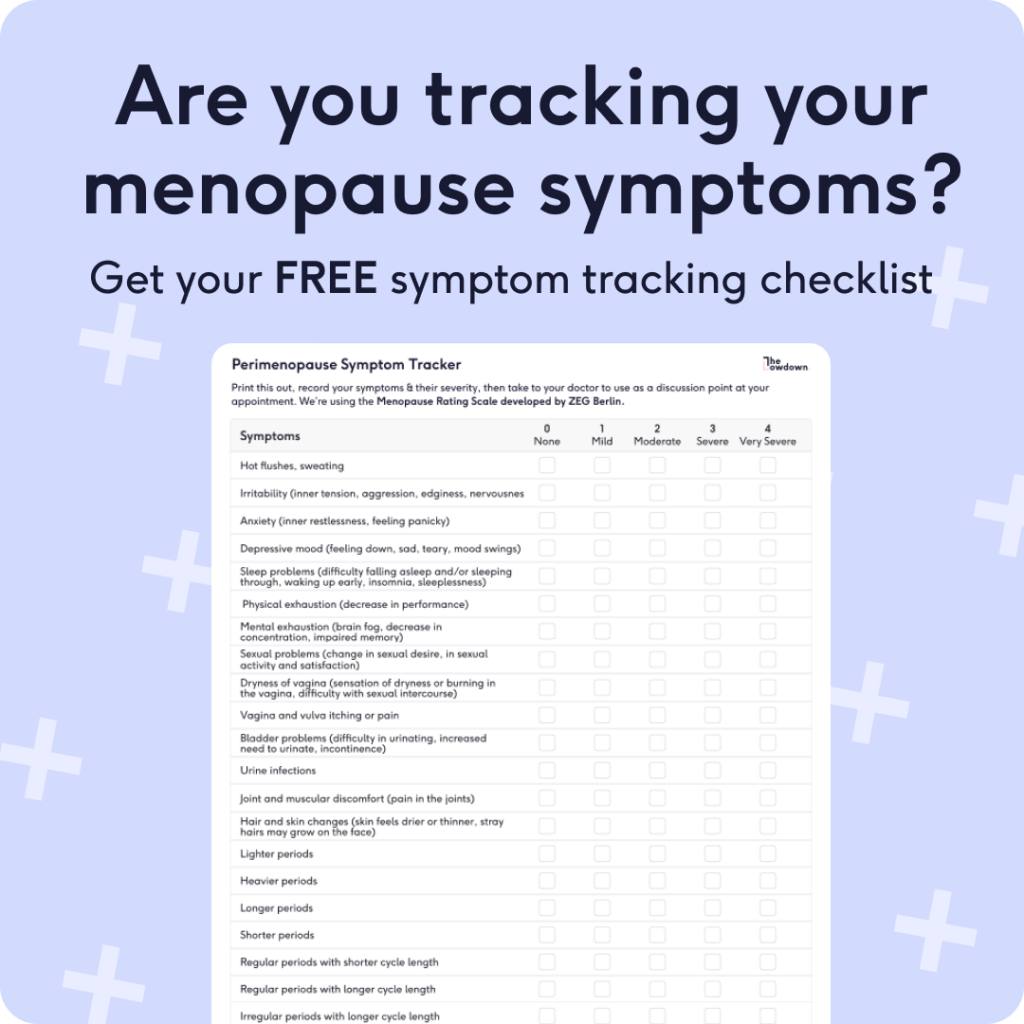
Perimenopause and hormone replacement therapy (HRT)
In this article
What's the lowdown?
HRT aims to treat perimenopausal symptoms
HRT can be started whenever you get perimenopausal symptoms and can be continued long term if you have annual check ups and your risks don’t change
HRT choice is based on several factors including your medical history, side effects and preferences
HRT can be used alongside contraception
You are likely to have heard about it one way or another – HRT is regularly in the media and everyone seems to have an opinion. Some people are HRT obsessives, others think it’s the devil. There are many conflicting articles and research studies around, but at The Lowdown we’re here to give you a balanced view on HRT as an individual.
If you have any other burning questions about perimenopause, we have tried to answer them all in our perimenopause-FAQs blog! If you think you’ll find this blog useful, sign up to our newsletter for loads more:
What is HRT for perimenopause?
HRT stands for hormone replacement therapy. It’s basically putting the hormones back in your body that are changing and reducing throughout perimenopause. The aim of HRT in perimenopause is to manage your symptoms and make you feel better.
How does HRT work?
Standard HRT contains two hormones: oestrogen and progesterone. It’s the oestrogen which generally helps the symptoms of perimenopause. In perimenopause your oestrogen levels fluctuate up and down. These fluctuations cause many of the symptoms you hear about; like hot flushes, brain fog, irritability and mood changes. By replacing the oestrogen, it keeps these levels stable and hopefully improves symptoms.
If you have a uterus, oestrogen can cause the womb lining to overgrow and over time, this can increase your risk of cancer of the womb.
So, we use progesterone alongside the oestrogen in HRT to protect your womb from this. This is called “endometrial protection”. It’s really important that you use both the oestrogen and progesterone together if you have a uterus.
Some people in perimenopause may also be prescribed testosterone, which is another hormone that can reduce during perimenopause and can contribute to low libido, mood change and brain fog.
How to choose HRT?
HRT can be a minefield, just when you may have got contraception sorted, more hormones to deal with! Here is a handy step by step guide on how to choose.
1. Do you have a womb?
If you have a womb then you will need both oestrogen and progestogen as part of your HRT. This is because taking oestrogen causes your womb lining to overgrow, over many years, this can increase the risk of cancer of the womb. Taking a progestogen alongside the oestrogen reduces this risk. If you have had a full hysterectomy, then you can take oestrogen only HRT. If you have had a subtotal hysterectomy, you may still require progesterone and should discuss this with your healthcare professional.
2. Are you having periods or not?
If you have had a period within the last 12 months, you are usually recommended to start on cyclical (also called sequential) HRT, or, to get a hormonal coil. Cyclical HRT is where the progesterone part of HRT is only taken for part of each month (usually 10-16 days). Cyclical HRT can prevent irregular and annoying bleeding that is a common side effect of HRT. After 5 years of cyclical HRT, or when you hit the age of 54, you should be switched to continuous HRT. Continuous HRT is when the dose of progesterone remains the same throughout the month as is designed to prevent any bleeds. You can start on continuous HRT if you have no periods due to hormonal contraception, or it has been around 12 months since your last period.
3. Consider your medical history
If you have previously had a blood clot or have risk factors for blood clots like smoking, family history or a high BMI, a form of oestrogen that is given through the skin (patch, gel or spray) is considered the safest option.
4. Think about your lifestyle
Are you someone who remembers to take things daily? Would you prefer something that needs minimal effort? Tablets, gels and sprays are taken daily, whereas patches only need to be changed twice a week and the hormonal coil can stay in for 5 years.
5. How do you feel about breast cancer risk?
There are several forms of progesterone that are used in HRT. Some types of progesterone are associated with a very small increased risk of breast cancer. If you are worried about breast cancer risk, for example due to family history, then you could choose a progesterone which studies have shown does not change breast cancer risk over the first 5 years of use such as utrogestan or dydrogesterone.
6. Do you want to take your oestrogen and progesterone together or split them up?
Taking both hormones together in a combined patch or tablet is more convenient BUT splitting the hormones can make it easier to change the doses and tailor your regimen to you.
Symptoms and side effects!
Some perimenopausal symptoms can be better treated by different HRT types. And, as with all medications, side effects can happen. This is the real art of HRT which women’s health experts can help you navigate. Our medical team or partner menopause specialists are on hand to help.
You can use our perimenopause and HRT areas to research the varying types of HRT and see real life reviews and advice about how they have helped and affected other women.

What’s the average age to start HRT?
The average age to start with perimenopausal symptoms is around 46. You can start HRT if you are experiencing perimenopausal symptoms, or wait until you feel ready. However, it is best to start HRT before the age of 60 and within 10 years of your last period, as this maximises the benefits.
How long can you be on HRT for?
You can be on HRT for as long as you need to. There is some controversy around this, as users were previously told to reduce and stop taking HRT after 5 years. This is partly due to the small increase in breast cancer risk with some types of HRT. However, nowadays, more and more specialists are suggesting that HRT can be continued for as long as needed.
Each year, you should be invited to have an HRT review. During this, your healthcare professional will make sure that you are still using the correct HRT regimen for you, screen for any problems with side effects and make sure you are still aware of all the risks and benefits of your HRT regimen. If the risks start to outweigh the benefits you get from the HRT, then they may advise you to wean down or switch treatments.
The exception is vaginal oestrogen HRT, this can be started in elderly women and continued long term without ever needing to stop.
Is body identical HRT better for perimenopause?
Body identical HRT means that the hormones included are the same chemical make up as the hormones our body naturally produces. All HRT contains body identical oestrogen. However, the progesterone part can either be synthetic (not exactly the same as our body) or body identical. Body identical progesterones have been shown to have no increased breast cancer risk for at least 5 years of HRT use. Synthetic progestogens may be associated with a small increase in breast cancer risk but are usually better at preventing bleeding side effects. Body identical HRT is better for perimenopause only if it suits you and you have tolerable side effects, if not, synthetic HRT may be a better option for you!
Which HRT is best for low libido?
HRT can often help improve low libido and manage menopausal symptoms. But we don’t know which regimen of oestrogen and progesterone is better to treat low libido yet as there is no research. By adding your experience to our perimenopause and HRT experience areas, you can help solve this question! Testosterone is an additional form of HRT which is licensed to be used for very low libido in perimenopause. Libido is very complex and there are often lots of factors which contribute, we have lots of tips about how to improve your libido from our sex coach Lucy.
Can HRT be used with contraception or birth control?
Yes, HRT can be used alongside contraception, and in fact, some types of HRT also act as birth control! During perimenopause, you can still get pregnant so if you’re sexually active, it’s important to consider contraception too. We have more in depth information in our perimenopause and contraception blog.
The hormonal coils Mirena, Levosert and Benilexa which are progestogen only contraceptives can be used as part of HRT for up to 5 years. The desogestrel based progestogen only pill can also be used in a double dose as both the progesterone part of HRT and as contraception, however, this is usually only done under the care of a healthcare professional who is experienced in menopause treatment.
HRT is an acceptable treatment option for perimenopause and loved by thousands of women. Make sure you understand all the risks and benefits, and use our experience area to do your research. If you want more individualised care, we have friendly menopause specialists to help!
You can also share your experience with perimenopause and menopause on our website, as well as search for any and all HRT reviews.
Our medical review process
This article has been medically reviewed for factual and up to date information by a Lowdown doctor.






